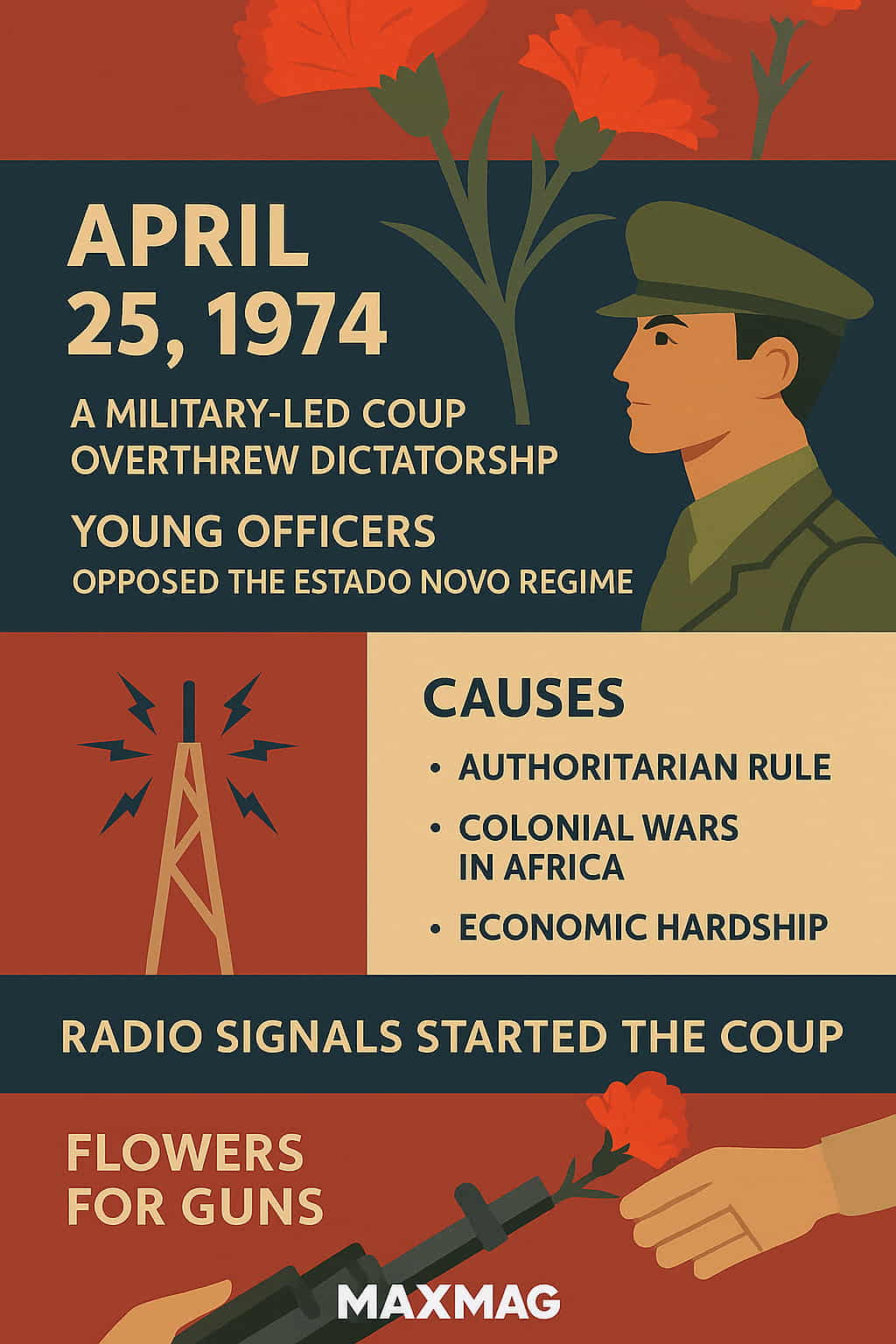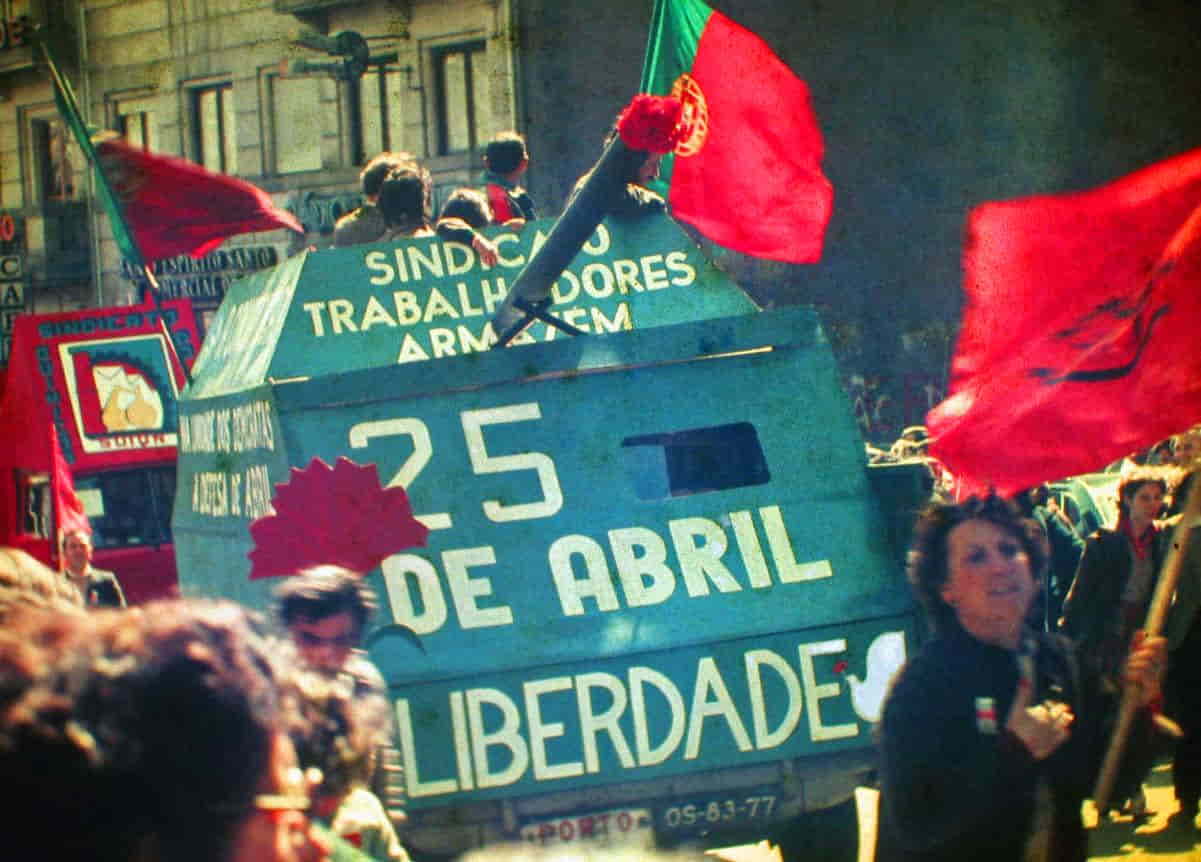
On the morning of April 25, 1974, Portugal awakened to an event unlike any other in its modern history. It was neither a violent revolt nor a dramatic civil war. Instead, it was a quiet, floral insurrection. Known today as the Carnation Revolution Portugal, this military-led coup overthrew decades of authoritarian rule and ushered in democracy—without firing a single fatal shot.
This momentous event remains one of the most inspiring chapters in European history. It not only dismantled the longest-running dictatorship in Western Europe but also ended Portugal’s colonial wars in Africa. Soldiers, ordinary citizens, poets, and musicians all played a role in this bloodless transformation that would influence politics, culture, and global movements for decades.
Seeds of Dissent: Life Under the Estado Novo Regime
To understand the magnitude of the Carnation Revolution Portugal, one must first appreciate the oppressive system it overthrew. The Estado Novo (New State) regime, established by António de Oliveira Salazar in 1933, was an authoritarian government cloaked in nationalist rhetoric and tight control.
For over four decades, censorship was omnipresent, the press was muzzled, and political opposition was silenced through surveillance and imprisonment. A secret police force, known as PIDE, instilled fear in every corner of the country. Elections were manipulated, and dissent was criminalized. Even basic civil liberties—like the right to assemble or speak freely—were denied.
The regime also dragged Portugal into lengthy and brutal colonial wars in Africa, particularly in Angola, Mozambique, and Guinea-Bissau, depleting national resources and causing massive conscription. Young Portuguese men were sent to distant lands, often with no clear cause, leading to increasing dissatisfaction among both soldiers and civilians.
📎 Read more on the roots of authoritarianism in Europe at Brookings Institution
Discontent Within the Army: The MFA Steps In
By the early 1970s, a secret network of junior officers began forming inside the military. These soldiers, disillusioned by the endless colonial wars and the lack of political freedom at home, founded the Movimento das Forças Armadas (MFA)—or Armed Forces Movement. Their goal wasn’t to stage a traditional coup for personal power, but rather to restore democracy to the nation.
This internal military resistance planned their move carefully. They developed coded messages and identified songs that would act as public signals when the time came. At 10:55 p.m. on April 24, the song “E Depois do Adeus” played on national radio—an apparently innocent Eurovision entry that served as the first signal. A few hours later, at 12:20 a.m., the revolutionary anthem “Grândola, Vila Morena” followed. That was the final call. The revolution had begun.
📎 Explore the psychology of peaceful protests via the American Psychological Association
The Morning of Change: April 25, 1974
As dawn broke, MFA troops took control of key sites across Lisbon, including government buildings, radio stations, and transportation hubs. Expecting resistance, they were surprised to find many citizens joining them in support. Cafés offered free drinks to soldiers, and people brought food to those holding positions in the streets.
A defining symbol emerged when a florist named Celeste Caeiro handed red carnations to soldiers in the capital’s Chiado district. Instead of bullets, soldiers placed these flowers into the barrels of their rifles. The image quickly spread—a flower replacing the gun’s firepower—forever giving the event its poetic name: the Carnation Revolution Portugal.
📎 See how nonviolent resistance shapes history at the U.S. Institute of Peace
The Fall of a Dictatorship
By midday, Prime Minister Marcelo Caetano, who had succeeded Salazar in 1968, was surrounded at the National Guard barracks. After a tense standoff, he agreed to resign on the condition that he would surrender only to General António de Spínola, whom he considered moderate. By evening, Caetano was flown out of the country to Brazil.
The regime was finished. And astonishingly, not a single person died from direct military action during the revolution. There were only four civilian casualties, caused by the regime’s loyal secret police firing upon demonstrators.
Within days, political prisoners were freed, censorship was abolished, and exiles began returning home.
📎 Learn more about democratic transitions at Freedom House
Carnation Revolution Portugal – A Turning Point for the Nation
The Carnation Revolution Portugal wasn’t just a military coup—it was a complete transformation of Portuguese society. Following the revolution, power was temporarily transferred to the National Salvation Junta, composed of moderate military leaders. However, the people demanded deeper change.
A period known as PREC (Processo Revolucionário Em Curso—“Ongoing Revolutionary Process”) followed. Between 1974 and 1976, Portugal underwent enormous social and economic reforms. Workers’ cooperatives formed, land was redistributed in rural regions like Alentejo, and major industries were nationalized.
This wave of change had both supporters and critics. Some feared a slide into communism, while others embraced the opportunity to reshape a more just and equitable society. Eventually, balance was found with the creation of a new democratic constitution in 1976.
📎 Explore economic shifts in post-revolution states with the Council on Foreign Relations
The End of Empire: Decolonization After the Revolution
Perhaps one of the most significant results of the Carnation Revolution Portugal was the rapid end of its colonial empire. In just two years, Portugal granted independence to Angola, Mozambique, Guinea-Bissau, Cape Verde, and São Tomé and Príncipe. This wave of decolonization ended more than four centuries of Portuguese overseas expansion.
However, it was not without consequences. Nearly one million Portuguese citizens, known as retornados, returned to the mainland from African colonies. Many arrived without homes, jobs, or clear futures. This mass migration put strain on housing, social services, and job markets, but also contributed to cultural diversification and change.
📎 Delve into modern post-colonial studies at Harvard’s Weatherhead Center
Music, Memory, and Meaning
Songs played a pivotal role in both launching and preserving the spirit of the revolution. “Grândola, Vila Morena,” composed by Zeca Afonso, was banned under the regime but became the revolution’s anthem. Its lyrics about brotherhood and equality perfectly captured the people’s aspirations.
Today, the song is still performed at civic events, and its lyrics are taught in schools. It is a reminder that words, poetry, and melody can become revolutionary weapons.
The carnation flower, too, has become more than a symbol—it is an annual ritual. Every April 25, the streets of Lisbon and cities throughout Portugal bloom with red and white carnations, held high by schoolchildren, veterans, and politicians alike.
📎 Discover how music drives social change at the Smithsonian Folkways
Carnation Revolution Portugal in Global Context
The Carnation Revolution Portugal had far-reaching implications beyond its borders. It served as a blueprint for nonviolent transitions to democracy, especially in Southern Europe. Spain and Greece, which were also under authoritarian rule, transitioned to democracy in the following years.
Portugal’s peaceful revolution stood in contrast to the often violent transitions in Latin America and parts of Asia during the same period. It also inspired pro-democracy activists in countries ranging from South Korea to South Africa, who cited Portugal as a hopeful example.
In 1986, Portugal joined the European Economic Community (now the EU), cementing its place in the democratic fabric of Europe.
📎 See how democratic ideals spread with Stanford’s Center on Democracy
Legacy of the Carnation Revolution Portugal
Nearly fifty years after it occurred, the Carnation Revolution Portugal continues to influence the country’s identity and civic life.
-
Freedom Day (Dia da Liberdade) is a national holiday, commemorated with concerts, parades, and cultural events.
-
Public schools incorporate lessons on the revolution into history curricula.
-
Museums and memorials ensure new generations remember the significance of peaceful resistance.
However, challenges remain. In recent years, Portugal, like many nations, has seen the rise of populist rhetoric and political polarization. Some worry that the spirit of April 25 is fading. But the revolution’s enduring legacy suggests that peaceful resistance, when combined with unity and vision, can still shape the course of nations.
📎 Explore global democratic health at the International IDEA Institute
FAQ
1. What is the Carnation Revolution Portugal?
It was a peaceful military-led coup in April 1974 that ended 41 years of dictatorship and transitioned Portugal to a democratic government.
2. Why is it called the “Carnation Revolution”?
Citizens gave carnations to soldiers during the uprising. The soldiers placed them in their gun barrels, turning weapons into peaceful symbols.
3. Who led the revolution?
The Armed Forces Movement (MFA), composed of disillusioned junior military officers, organized and executed the coup.
4. Was the revolution violent?
No. It was remarkably peaceful, with only a few casualties. No shots were fired by the revolutionaries to cause harm.
5. What happened after the dictatorship fell?
Portugal underwent significant reforms, decolonized its African territories, and eventually became a stable democracy by 1976.
6. Is the Carnation Revolution still celebrated?
Yes. April 25 is a national holiday known as Freedom Day, marked by events across Portugal celebrating democracy and peace.








